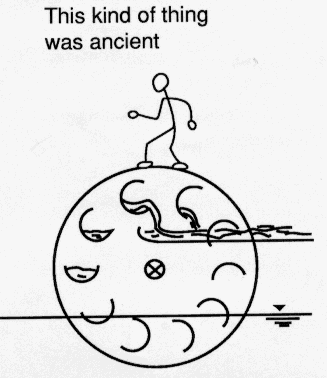The Wheel Revisited
Today, another look at the invention of the wheel. The University of Houston's College of Engineering presents this series about the machines that make our civilization run, and the people whose ingenuity created them.
It's fairly common knowledge that the wheel was invented around 5500 years ago. But what was really invented at that time? V. Gordon Childe offers an interesting slant on the question. What we should be looking at, he says, is not the wheel itself, but rather the use of rotary motion.
The human wrist/arm configuration allows 360-degree rotation. That's why hand drills using back and forth hand motions are among the oldest tools. Late stone age artisans extended that rotation with various pivoted devices. A primitive spinning spindle plays out wool or flax fibers while the operator keeps it moving with thumb and forefinger. Early doors, with a vertical shaft on one side, were anchored in sockets that let them swing open and shut.
The next step in sophistication was using bowstrings to drive back-and-forth rotary motions of drills and fire starters. These devices all ran one way to a limit, and then had to unwind. Continuous rotation was the conceptual hurdle. Two primary examples, the vehicle wheel and the potter's wheel, arose about the same time.
A potter's wheel is a horizontal turntable that holds a lump of clay and turns at least 100 rpm. Childe finds one potter's wheel from the region of the Tigris and Euphrates rivers (or present-day Iraq) from as early as 3300 BC. The earliest vehicle wheel turns up in a cuneiform document from same region in 3500 BC.
Those dates don't differ much, and examples are too rare to fix dates accurately. So, to the best of our knowledge, not just the wheel, but continuous rotation itself, dates from five and a half millennia ago in the Fertile Crescent of the ancient world. Another invention, closely kin to the wheel, was the compass for making circles. The first hinged compasses also trace to that same region, 5500 years ago.
Early wheels show a progression of understanding. The first wheels were cut from huge wooden slabs, built up of boards. In other words, the lay of the wood seems to fight the rotary motion it's meant to accomplish. It's not 'til 2000 BC that we find wheels with spokes. The spoke itself introduces a new subtlety since it's loaded in tension, not compression. A vehicle hangs on the wheel's upper spokes; it doesn't ride on the lower ones.
Other questions of rotation had to be answered: Wheels are best left free to rotate on a fixed axis. If they're anchored to a rotating axle, then they can't turn at different speeds going around a corner. The idea of a swiveled front axle, that can turn into a curve, is barely 2000 years old.
And so it is not the wheel itself, but the problem of rotation, that has dogged our minds for thousands of years. What the ancient Sumerians did was to recognize the problem. And we have (if I may) spun out the subtle ramifications ever since.
I'm John Lienhard, at the University of Houston, where we're interested in the way inventive minds work.
(Theme music)
Childe, V. G., Rotary Motion. A History of Technology, Vol 1, From Early Times to Fall of Ancient Empires (S. Singer, E. J. Holmyard, and A. R. Hall, eds.). New York: Oxford University Press, 1954, Chapter 9.
Williams, T. I., The History of Invention. New York: Facts On File Publications, 1987, Chapter 4.
The oldest extant wheel is to be found in the City Museum of Ljubljana. See: The Ljubljana Marshes Wheel.
An early Engines program, Episode 24, also deals with the invention of the wheel and the crank.
In Jan, 2000, when this program reran, listener Leslie R. Denham took issue with my too-hasty remark about spokes being loaded in tension. He pointed out that that tensioned spokes didn't come into general use until much later. I include his full statement below since it is of great interest in its own right.
My grandfather was a wheelwright, so I have always had an interest in traditional wooden spoked wheels. The spokes are mortised into the wooden hub, and into the felloes or fellies which make up the wooden rim, without any kind of fastener. The whole assembly is held together by the iron tire which is heated and then dropped over the wooden parts, shrinking as it cools to tighten the wooden parts.
A lot of my grandfather's business in the dying days of his profession was "cutting and shutting": cutting an iron tire which had become loose as the wooden parts had shrunk and worn, welding it back with a slightly smaller diameter (hammer welding in the forge, of course) and shrinking it back onto the wooden wheel.
With this type of construction, which remained the same from the early days of the Iron Age until the early 20th century, the spokes did not function as tensional members. I have always thought that the first tension wheels were bicycle wheels, which were invented in the 19th century. These wheels clearly have the load taken by the upper spokes. The spokes are fastened to the rim in a way which will not take any compressional loading, by a nut on the outside of the rim.
The spoked wooden wheel was improvement over the built-up wheel in that it separated the load-carrying function from the road-smoothing function of the rim, but its upper spokes did not yet carry any of the load.


